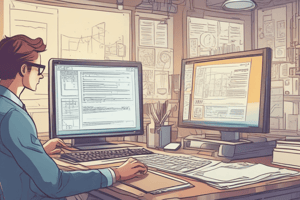Podcast
Questions and Answers
What is the primary focus of functional requirements?
What is the primary focus of functional requirements?
- User satisfaction and system longevity
- Non-functional quality metrics
- Quality and performance characteristics
- Specific functions and behaviors (correct)
Which of the following best describes non-functional requirements?
Which of the following best describes non-functional requirements?
- They outline user interactions
- They concern quality and performance characteristics (correct)
- They define system specifications in detail
- They focus on system behaviors
Why is clear and specific documentation important?
Why is clear and specific documentation important?
- It prevents scope creep and enhances understanding (correct)
- It can lead to misinterpretation
- It allows for more complex project management
- It complicates communication across teams
How should non-functional requirements be tested?
How should non-functional requirements be tested?
Which of the following is an example of a non-functional requirement?
Which of the following is an example of a non-functional requirement?
What characterizes testable and measurable requirements?
What characterizes testable and measurable requirements?
Which of the following principles is NOT relevant to requirements documentation?
Which of the following principles is NOT relevant to requirements documentation?
What is the impact of ambiguity in requirements documentation?
What is the impact of ambiguity in requirements documentation?
What is one of the main components of a use case?
What is one of the main components of a use case?
Which of the following describes the format for writing a User Story?
Which of the following describes the format for writing a User Story?
What is NOT a component of acceptance criteria?
What is NOT a component of acceptance criteria?
What does the acronym '3Cs' in User Stories stand for?
What does the acronym '3Cs' in User Stories stand for?
Which statement best describes an 'actor' in a use case?
Which statement best describes an 'actor' in a use case?
What is the purpose of alternative flows in a use case?
What is the purpose of alternative flows in a use case?
How are acceptance criteria typically structured?
How are acceptance criteria typically structured?
What is the primary goal of a User Story in agile methodology?
What is the primary goal of a User Story in agile methodology?
Flashcards
Software Requirements
Software Requirements
Written descriptions that outline the desired behavior and features of a software system.
Functional Requirements
Functional Requirements
Describe specific actions or functionality that a software system must perform. Examples include login, searching, and processing payments.
Non-Functional Requirements
Non-Functional Requirements
Address the quality, performance, and non-functional aspects of a software system. Examples include security, speed, and user experience.
SRS (Software Requirements Specifications)
SRS (Software Requirements Specifications)
Signup and view all the flashcards
Clear and Specific Requirements
Clear and Specific Requirements
Signup and view all the flashcards
Testable Requirements
Testable Requirements
Signup and view all the flashcards
Consistent Requirements
Consistent Requirements
Signup and view all the flashcards
Concise Requirements
Concise Requirements
Signup and view all the flashcards
Software Requirements Specification (SRS)
Software Requirements Specification (SRS)
Signup and view all the flashcards
Use Case Diagram
Use Case Diagram
Signup and view all the flashcards
Use Case
Use Case
Signup and view all the flashcards
User Story
User Story
Signup and view all the flashcards
Acceptance Criteria
Acceptance Criteria
Signup and view all the flashcards
3Cs of User Stories
3Cs of User Stories
Signup and view all the flashcards
INVEST
INVEST
Signup and view all the flashcards
Study Notes
Class#4 - Requirements Documentation
- This class focuses on the requirements for documentation of software.
- The question presented is whether software needs documentation, and why it is important to maintain documentation for software.
Working Software Over Documentation
- The question explored is whether working software eliminates the need for documentation.
- The answer is no, as documentation helps various teams understand the software, avoids scope creep, and facilitates collaboration among developers.
Why Document?
- Good documentation ensures understanding across teams.
- It helps avoid scope creep and facilitates collaborative efforts among developers.
- Principles of Requirements Documentation:
- Clear and specific requirements to avoid misinterpretations.
- Testable and measurable requirements, especially for non-functional aspects.
- Consistent and concise information for clarity and precision.
- Requirements should be complete, consistent, precise, and concise.
SRS Document (Software Requirements Specifications) Functional vs Non-Functional
- SRS documents outline software requirements.
- Functional requirements describe specific functions and behaviors of the software.
- Non-functional requirements describe quality and performance characteristics, such as performance, security, usability, testing, system speed, and security standards, uptime, scalability.
Example
- Functional and non-functional requirements are explained for Login System, Product Search, Payment Processing, and Order Tracking features.
- Examples provided include login speed, search result loading time, security requirements, and order update speed.
Example SRS Document
- This provides a template for a detailed software requirements specification (SRS).
Example Use Case Diagram
- A diagram illustrating the actors and their interactions with the online ordering system.
- Includes actors like Prospective Customer, Customer, Procurement Manager, and Service Representative.
- The system includes actions such as create profile, expedite order, view menu, place order, change order, view reports, update prices, and get ingredient requests.
- Links show actions between different actors and the system.
Use Cases
- Components of a use case include actors, description, preconditions, basic flow, alternative flows, and dependencies.
- Actors are individuals or systems interacting with the system.
- Description summarizes the main goal or objective.
- Preconditions define prerequisites before a use case can start.
- Basic flow describes critical interactions and actions between actors and the system.
- Alternative flows detail variations or alternative paths.
- Dependencies identify related use cases, systems, or modules.
User Story
- A user story is a high-level description of a user's need or goal.
- User stories capture what a user does or needs to do as part of their work.
- Details might not be as extensive as in a use case, focusing on eliciting conversations through questions during scrum meetings.
How to Write a User Story
- Structure: As a [persona], I [want to], so that [benefit].
- Acceptance criteria define conditions of satisfaction to verify requirements.
User Story 3Cs
- Components include card (on a post-it note), conversation (with the development team), and confirmation (of acceptance criteria).
Acceptance Criteria
- Acceptance criteria clearly define the scope, desired outcomes, and testing criteria for software features.
- This is crucial for communication between product owners and developers.
- The list of acceptance criteria often uses "Given, When, Then" approach to describe conditions/situations.
Example
- A sample "Given, When, Then" scenario is provided, illustrating how to define observable consequences based on given conditions and actions.
INVEST
- Criteria for evaluating user stories, including Independent, Negotiable, Valuable, Estimable, Small, and Testable.
Story Slicing Phases
- Two phases in story slicing are discussed
- Phase 1: Focus on the user and goal
- Phase 2: Gather more details on implementation
Story Mapping With Personas
- Story mapping with personas is a technique for organizing user stories into a visual representation of flow and user journeys.
Martha's Story
- User story about a user who wants to buy pizza with friends but doesn't have cash.
Visual Story Slicing
- Detailed illustrations and diagrams describe scenarios for a user's actions
- For example, using card payment at ATM
Indicators of Poor User Stories
- Recognizing warning signs of poorly defined user stories to avoid difficulties during development
- Examples include: significant questions during sprint planning, rework, missing sprint commitments, and surprising product owners.
Further Considerations
- Emphasis on avoiding distractions by focusing initially on the core functionality rather than nonfunctional or supportive details.
Studying That Suits You
Use AI to generate personalized quizzes and flashcards to suit your learning preferences.




